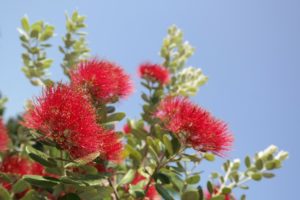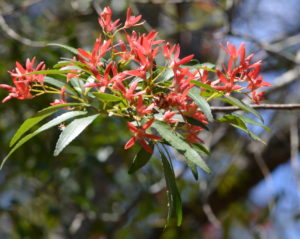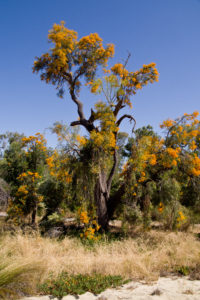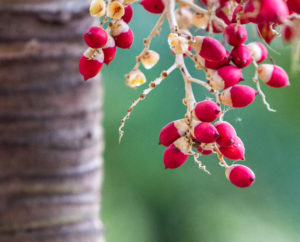Here in Canada, our days are getting shorter and the autumn leaves have faded and fallen. Neighbourhood strolls are now reserved for admiring trees crisscrossed with decorative lights, or peering through frosted eyelashes to observe branches after a delicate dusting (or dump!) of snow.
But down in the Southern Hemisphere, summer is only just beginning. While we’re encouraged not to travel this year, we’d like to take you on a virtual journey south, introducing you to a few species of trees that reach their peak during this festive season.
The Kiwi Christmas tree

If you’ve ever visited New Zealand, you’ll likely remember coming across the distinctive Pōhutukawa tree (Metrosideros excelsa). For most of the year, the Pōhutukawa is recognizable for the gnarly branches that twist out from its trunk, and its waxy leaves with a hairy underside. Its bark is rough and stringy, designed to protect the tree from drought conditions. It looks old and wise, and Pōhutukawa trees can live up to 1,000 years.
Come December, Pōhutukawa trees take on an entirely different appearance. Huge flowers bloom around the crown of the tree, and the Pōhutukawa turns a fiery crimson red. The blossoms typically reach their peak in mid to late-December, and so festive are the florals that the Pōhutukawa tree has been nicknamed New Zealand’s Christmas tree.
Though today synonymous with the Christian holiday, Pōhutukawa trees have long been sacred and significant to Māori tribes, the Indigenous peoples of Aotearoa (New Zealand).
Beautiful and unique
Hop across the Tasman Sea and you’ll find that Australians have a number of similarly ornamental trees.

One of the best known is the New South Wales Christmas bush (Ceratopetalum gummiferum), found throughout the country’s most populous state. The Christmas bush starts as a shrub before maturing to become a small tree.
Like the Pōhutukawa, the New South Wales Christmas bush is most ornate around December. Uniquely, it is the sepals that turn a red-pink as opposed to the petals themselves. Typically green, sepals are the part of the flower that enclose the petals before they bloom. On the New South Wales Christmas bush, it’s the sepals that shine, and the petals remain small and white.

“Travel” to Australia’s southwest around this time of year and you’re bound to come across a flowering Moodjar, commonly known as the West Australian Christmas tree (Nuytsia floribunda). Unlike the crimson-hued trees featured already, the West Australian Christmas tree blooms are a vivid orange-yellow.
Curiously, the West Australian Christmas tree is a bit of a Grinch. Its roots are equipped with blades that enable it to slice into the roots of neighbouring plants in order to steal their sap. Even internet cables and telephone lines aren’t spared!
Like the Pōhutukawa, the Western Australian Christmas tree is considered sacred by the Noongar, a group of Aboriginal Australian tribes.
Oh Christmas…palm?

Native to the Philippines but found today across the tropics, the Christmas palm (Adonidia merrillii) was named for the bunches of oval-shaped fruits that ripen bright red just in time for the December holiday season. The fruit hangs in clusters around the trunk, resembling Christmas ornaments. Though it’s not its flowers that make the Christmas palm notable, its rich-coloured fruit, fluorescent green fronds, and relatively compact size make the Christmas palm appropriate for both indoor and outdoor spaces.
So while we cozy up for the winter months ahead, perhaps you can change your desktop screensaver or Zoom background to include one of the festive trees we’ve mentioned here. Wherever you are, have a safe holiday season!
Back to all articles